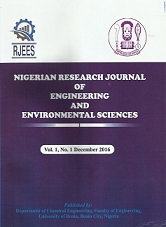Chemical and Textural Properties of Melon Seed Shell-Derived Biochar Relevant to their Application in the Remediation of Contaminated Soil
Authors: Ogede, L.O., Ejimadu, C.M. And Okieimen, F.E.
DOI Info: http://doi.org/10.5281/zenodo.14566003
ABSTRACT
In this study, biochar samples obtained by pyrolysis of melon seed shells at different temperatures (300 – 450 oC) were characterized for their potential as amendment materials in the remediation of contaminated soil. It was found that the marked decrease in the yield of the biochar (56.60 – 29.70%) with increase in pyrolysis temperature was associated with an increase of about 2.0 pH units in the pH of the biochar samples. Surface morphology and Brunauer Emmett Teller (BET) particle analysis of the samples show that all the biochar samples are microporous. The BET surface are MSSB300 (288.42 m2.g-1), MSSB350 (355.36 m2.g-1), MSSB400 (472.28 m2.g-1), and MSSB450 (633.91m2.g-1) and the pore volume MSSB300 (0.18 cm3.g-1), MSSB350 (0.23 cm3.g-1), MSSB400 (0.29 cm3.g-1), and MSSB450 (0.36 cm3.g-1) (cm3.g-1) increasing with an increase in pyrolysis temperature. The elemental composition of the biochar samples gave relatively low levels of nutrient elements, with Na ranging from 0.54–1.58 wt%, Ca from 0.44–3.95 wt%, K from 1.19–3.06 wt%, Mg from 0.67–3.69 wt%, N from 0–0.75 wt%, and P from 0.21–1.34 wt%. In addition, the O/C ratios were lower than 1.0 and tended to decrease with increase in pyrolysis temperature. Surface functional groups on the biochar samples were determined qualitatively by FTIR and surface acid functional groups, phenolic, lactonic and carboxylic acids determined quantitatively showed little variation with pyrolysis temperature. These results indicate that the mesoporous melon seed shell-derived biochar could be used as an amendment for soil remediation.
Affiliations: Centre for Biomaterials Research, Department of Chemistry, University of Benin, Benin City, Nigeria.
Keywords: Biochar, Pyrolysis, Soil Remediation, Melon Seed Shells, BET Analysis, Nutrient Elements
Published date: 2024/12/30









